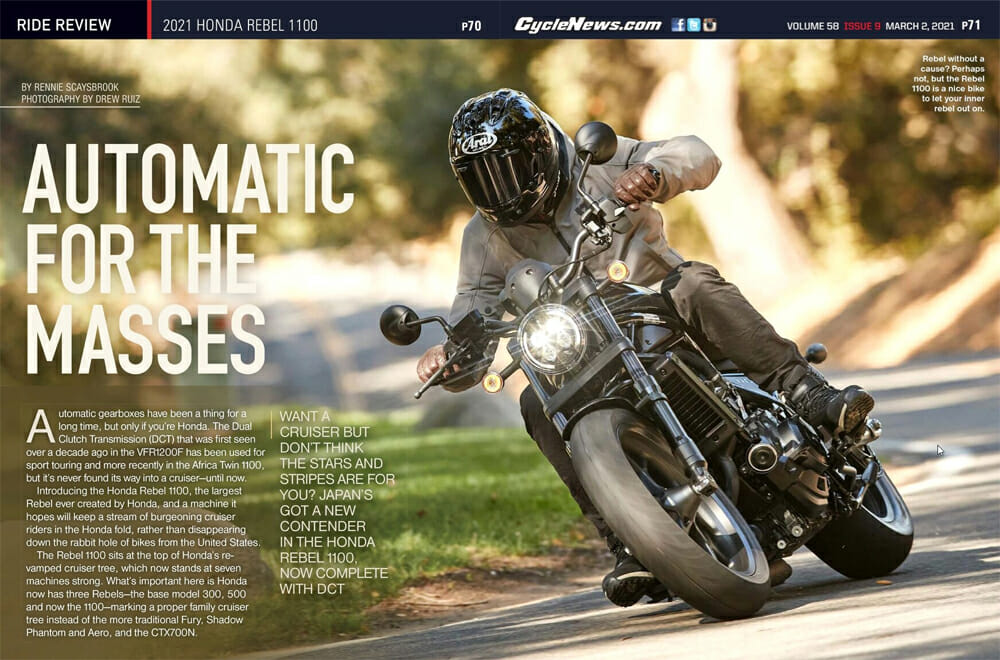Rennie Scaysbrook | March 7, 2021
Want a cruiser but don’t think the Stars and Stripes are for you? Japan’s got a new contender in the Honda Rebel 1100, now complete with DCT.
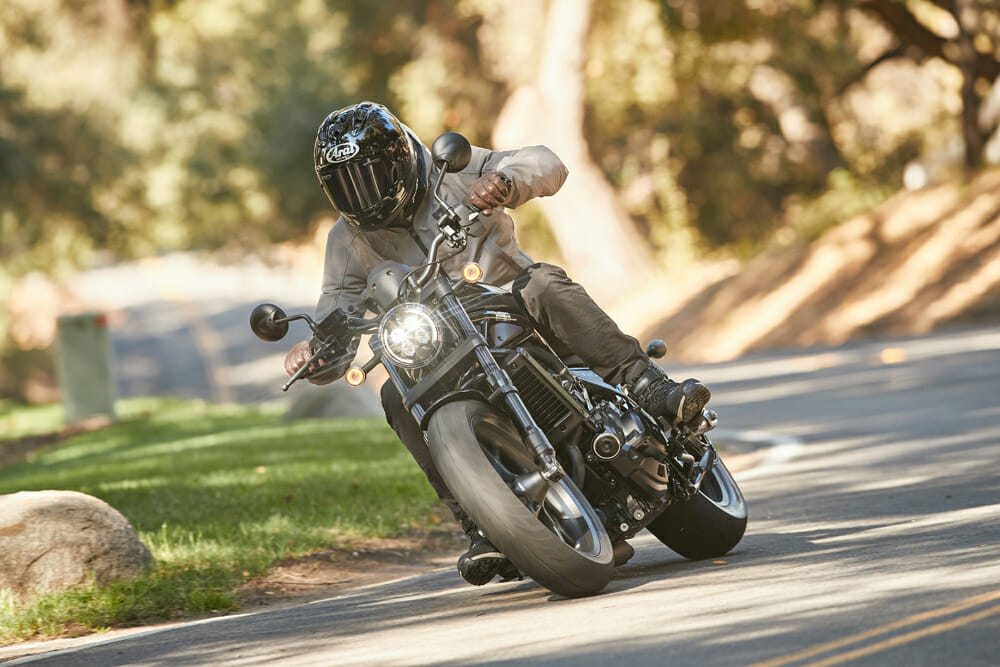 Rebel without a cause? Perhaps not, but the Rebel 1100 is a nice bike to let your inner rebel out on.
Rebel without a cause? Perhaps not, but the Rebel 1100 is a nice bike to let your inner rebel out on.
Photography by Drew Ruiz
Automatic gearboxes have been a thing for a long time, but only if you’re Honda. The Dual Clutch Transmission (DCT) that was first seen over a decade ago in the VFR1200F has been used for sport touring and more recently in the Africa Twin 1100, but it’s never found its way into a cruiser—until now.
Introducing the Honda Rebel 1100, the largest Rebel ever created by Honda, and a machine it hopes will keep a stream of burgeoning cruiser riders in the Honda fold, rather than disappearing down the rabbit hole of bikes from the United States.
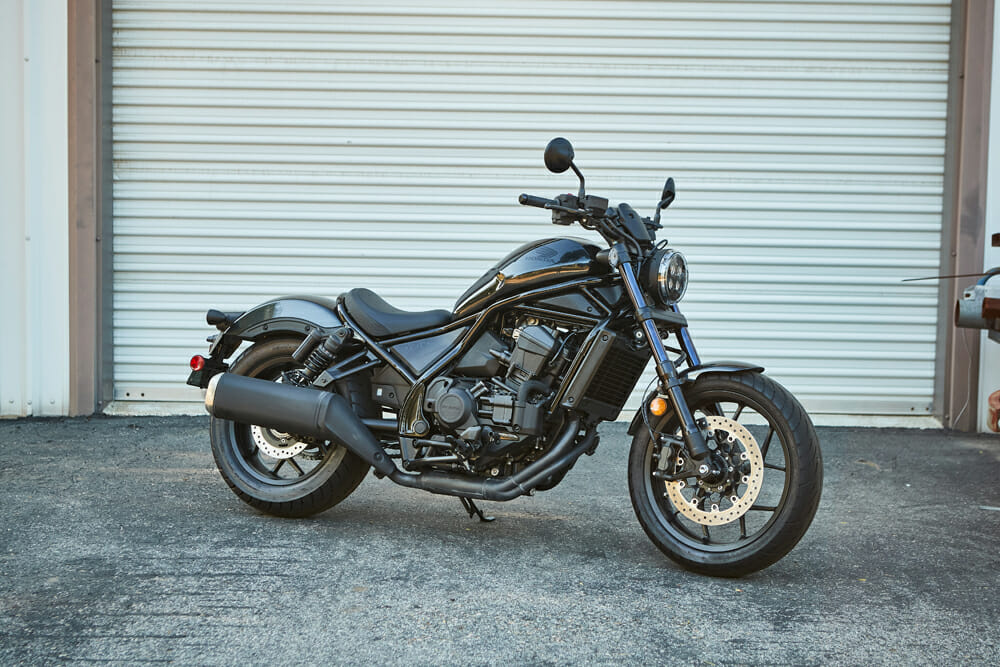 The all-black looks menacing but Honda says this is a clean slate for customizing.
The all-black looks menacing but Honda says this is a clean slate for customizing.
The Rebel 1100 sits at the top of Honda’s revamped cruiser tree, which now stands at seven machines strong. What’s important here is Honda now has three Rebels—the base model 300, 500 and now the 1100—marking a proper family cruiser tree instead of the more traditional Fury, Shadow Phantom and Aero, and the CTX700N.
The Rebel 1100 is not so much a cruiser for cruiser’s sake but a new take on the segment that’s dominated by Harley-Davidson and Indian. Honda wants riders to customize their Rebels, and the fact it costs less than $10K makes changing aesthetic features not as daunting as on a $20K Indian.
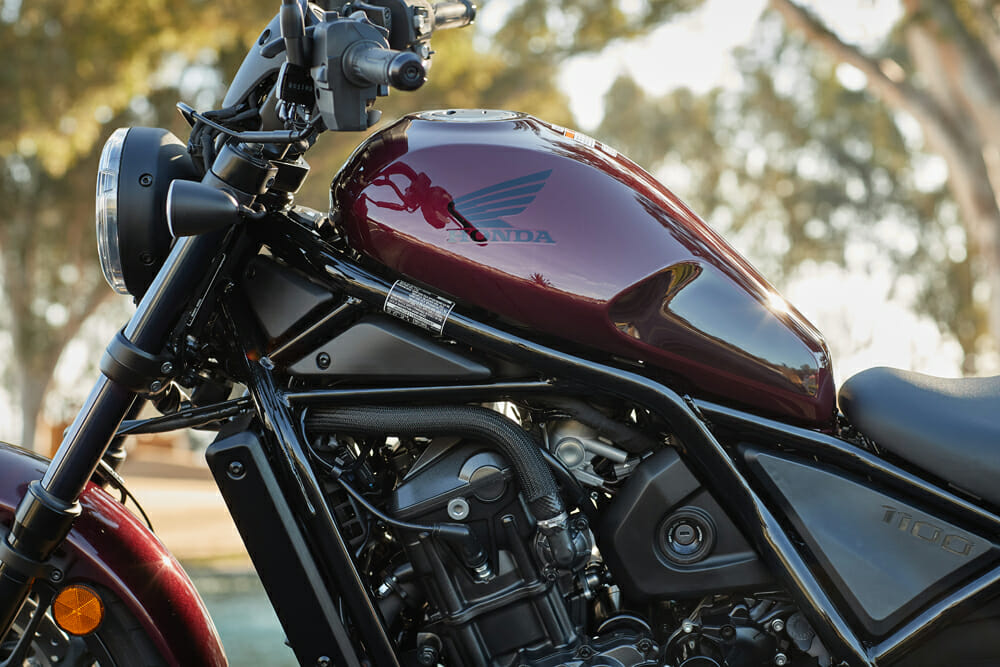 That tank isn’t overly comfortable for riders with long legs.
That tank isn’t overly comfortable for riders with long legs.
Using the Africa Twin’s 1084cc parallel twin as the donor powerplant, the Rebel gets a slight internals rework compared to its adventure sibling. The cam timing is changed, and the flywheel is 20 percent heavier, increasing the moment of inertia and creating what Honda says is “enhanced cylinder pulsing” low rpm—although to my ears it still feels like a traditional Africa Twin motor that doesn’t rev as quickly.
Regardless, in performance the single-cam parallel twin is a gem of a motor. If you’ve ever ridden an Africa Twin, you’ll know what I mean but, if anything, I feel this motor is even more suited to the cruiser segment than the ADV one.
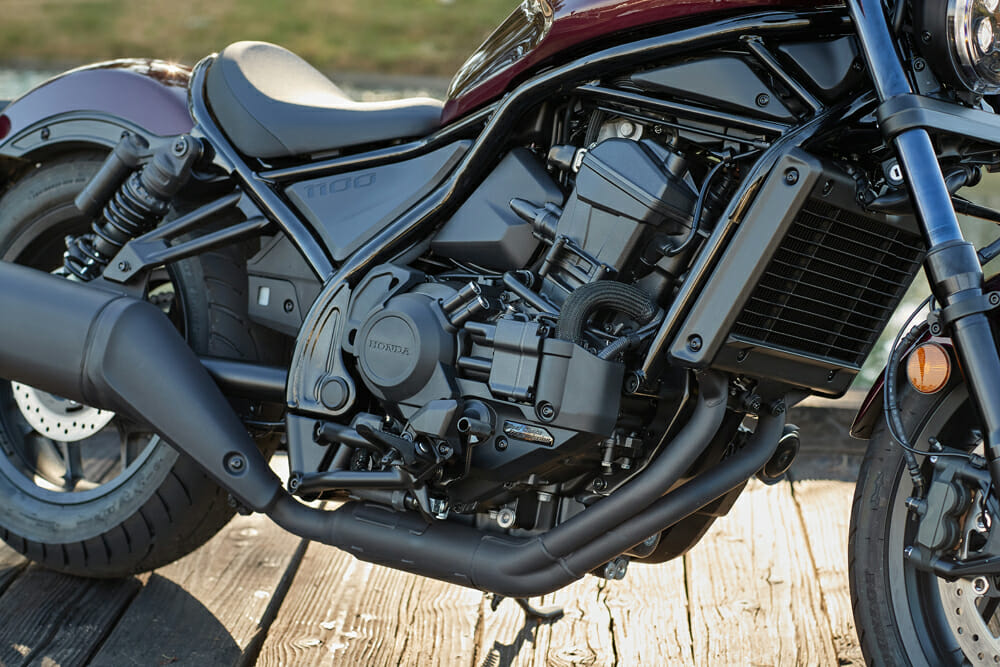 The DCT has its foibles but it’s a good overall system.
The DCT has its foibles but it’s a good overall system.
Power is delightfully smooth, and the droning exhaust note almost limits your desire to go revving the thing out when in Sport mode on the auto gearbox. The Rebel redlines at 8000 rpm, but all the meaningful drive is done by about 7000 rpm and it greatly prefers to be lugged from corner to corner in higher gears, keeping the revs nice and low. This is a cruiser, after all.
There are three preset power modes of Standard, Sport and Rain, each of which has its own level of traction control/wheelie control (they are part of the same algorithm) engine-brake control and DCT, and you get a programmable “User” mode that lets you individually set all those aforementioned parameters.
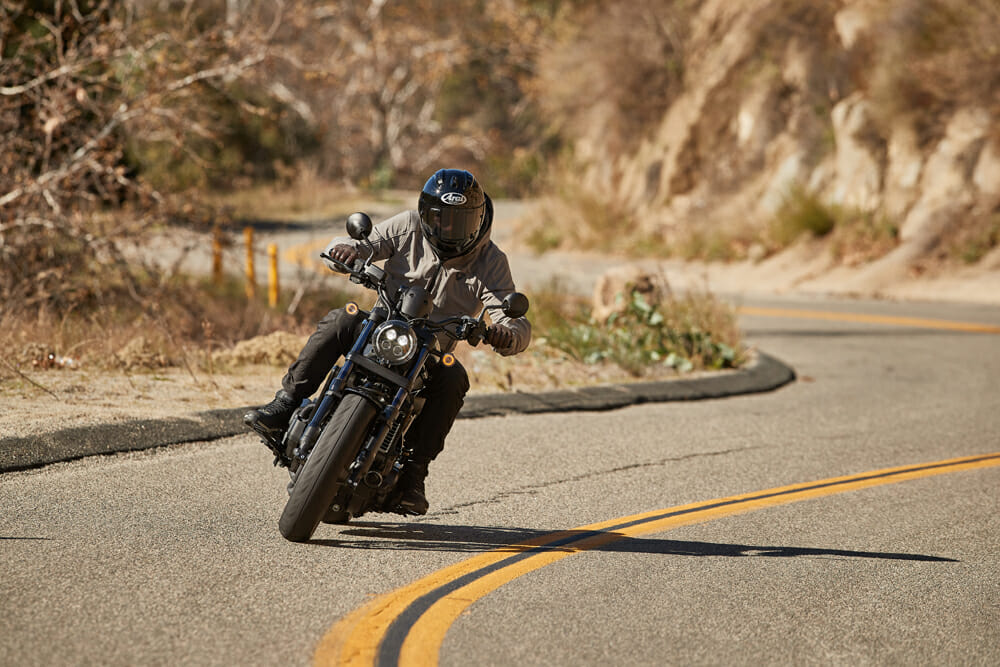 You can hustle the Rebel along quite nicely, especially for a cruiser.
You can hustle the Rebel along quite nicely, especially for a cruiser.
You can get a manual Rebel 1100, but we only tested the DCT version at the launch. The DCT itself comes with three modes—level one for highway riding that will see you in sixth gear before you know it; level two for commuting where it holds the gear for a touch longer; and level three, where it holds the chosen gear for a long time to maximize acceleration.
Even though Honda is the champion of the auto gearbox, there’s still some foibles with the system. Aside from simple cruising, where revs didn’t matter, and I just motored from corner to corner, if I used level three on the DCT, it would hold gears for way too long and I would constantly need to shift via the paddles on the left handlebar. It was a similar situation in level two but in reverse, as the DCT would sometimes not shift fast enough for the given situation. If I then got a little throttle happy, it would kick back down the gears, rev right out and then revert to holding gears for too long.
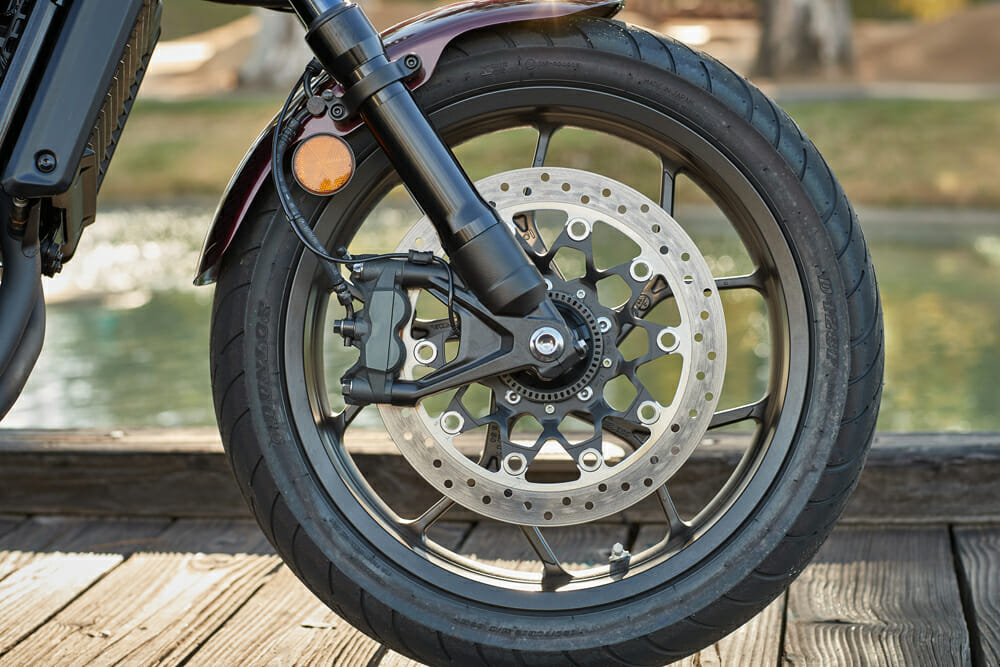 Four-piston brakes are more than enough for this bike.
Four-piston brakes are more than enough for this bike.
About the only time I was truly happy with the DCT system in auto mode was in level one, where the Rebel hits sixth gear quickly and the ride is smooth and serene. As mentioned, you can override the DCT at any point by using the paddle shifters on the left handlebar, and when you’re really going for it, shifting with your hands is great fun. But in some ways, it kind of defeats the purpose of having an auto gearbox—the saving grace here being that when you’re just cruising and in no hurry in level one, the system works brilliantly.
As for the fitment of the Rebel, riders under six feet tall will have no problems at all. However, at 6’1,” I found the shape of the tank to be a little annoying. Honda has carved out knee indents in the teardrop tank that, if you’ve got long legs, are quite difficult to tuck into, the result was my knees sat at the top crease of the knee indents and it wasn’t terribly comfortable.
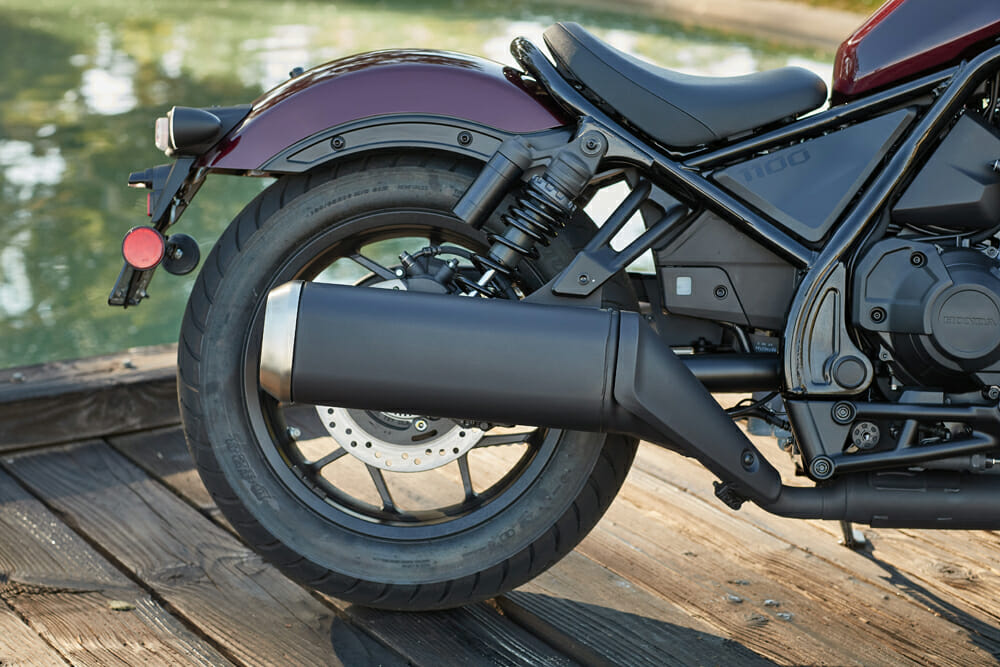 The pipe isn’t exactly the prettiest thing out there.
The pipe isn’t exactly the prettiest thing out there.
Shorter riders will have no issues, but it’s something to be mindful of for taller guys and girls out there.
Having said that, the seat position is quite nice in that it doesn’t curve your lower back too much like so many cruisers from Indian and Harley-Davidson. You’re not exactly bolt upright and instead in more of a small slouch, but a full day in the saddle wasn’t too painful.
You can hustle the Rebel on pretty well, especially for a cruiser. You’ve got 35-degrees of cornering bank angle on the Rebel, which is miles more than the equivalent machines from the U.S. The Rebel will rip through corners with serious pace, with the ride offered by the Showa fork and twin shocks at the back plush but capable of hitting the twisties.
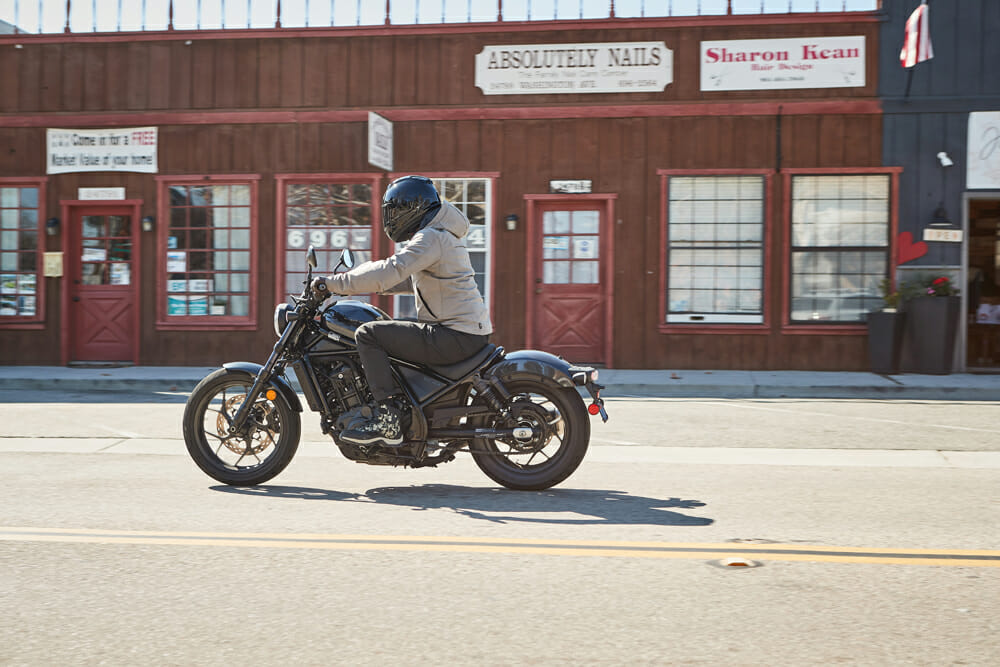 The neutral riding position means big days aren’t an issue on the Rebel.
The neutral riding position means big days aren’t an issue on the Rebel.
Considering the price of under $10K for a DCT Rebel, Honda has made a serious push into the high-capacity cruiser market that’s impossible to ignore. The fact the Rebel isn’t going after traditional cruiser riders speak volumes, as the younger crowd isn’t particularly drawn to a single brand yet and it’s a market Honda can easily exploit.
The Rebel itself is a good little bike. Those DCT foibles and the fitment aside, I had a great time on it during my day in SoCal, and I’d be surprised if I don’t start seeing many more of these on the roads in the coming years. CN
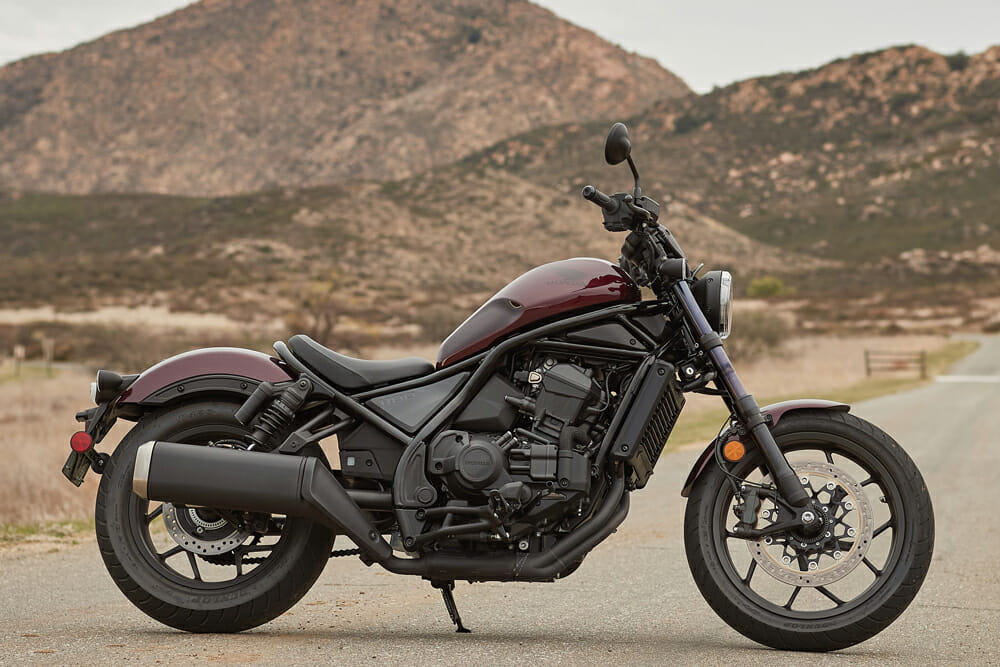
2021 Honda Rebel 1100 Specifications
| MSRP: |
$9299 / $9999 DCT |
| Engine: |
Parallel twin |
| Valvetrain: |
SOHC, Unicam, 8-valve |
| Displacement: |
1084cc |
| Cooling System: |
Liquid |
| Bore x stroke: |
92 x 81.5mm |
| Fuel injection: |
PGM-FI electronic fuel injection 46mm throttle bodies |
| Exhaust: |
2-2-1 |
| Transmission: |
DCT 6-speed |
| Chassis: |
Aluminum monocoque |
| Front suspension: |
43mm conventional telescopic fork, spring preload adjustable |
| Rear suspension: |
Dual Showa shocks, piggyback pressurized reservoirs, spring preload adjustable |
| Front-wheel travel: |
5.5 in. |
| Rear-wheel travel: |
3.7 in. |
| Front brake: |
4-piston monoblock, radial-mount hydraulic caliper, floating 330mm disc, ABS |
| Rear brake: |
265mm disc, 1-piston caliper, ABS |
| Front tire: |
Dunlop D428 130/70-18 in. |
| Rear tire: |
Dunlop D428 180/65-16 in. |
| Rake: |
28° |
| Wheelbase: |
59.8 in. |
| Seat height: |
27.5° |
| Fuel capacity: |
3.6 gal. |
| Weight (curb, claimed): |
509 lbs. |
